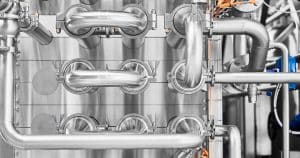Food Safety Takes Priority in Design pt 1

Modern food production systems have reduced the cost of foods and made them more available, but general trends towards the centralization of food supply also increases the opportunity that food safety issues, such as contamination with pathogens or toxins will affect large numbers of people¹.
The contamination of food and drink products can cause anything from minor quality issues to severe health outcomes and even death. There are four main types of contamination which can affect food and drink products: microbial, chemical, physical and allergenic.
Food processing business adopt a range of processes and procedures to prevent these forms of contamination from occurring. These measures may include cleaning and maintenance procedures, pest control, personal hygiene, protective clothing, dress codes, etc. Many of these procedures will have been implemented as a result of Hazard Analysis Critical Control Points (HACCP) assessment of the facility and the production methods employed, but there is another equally important aspect of avoiding contamination which is not always given such a high profile: the design and construction of the food processing equipment itself.
Hygienic equipment design enhances cleanability, decreasing the risk of biological, physical and chemical contamination. In addition, equipment that is designed and constructed to meet hygienic principles is easier to maintain and reduces the risk of physical hazards².
Hygienic design principles encompass a range of different factors, including material choice, surface finish, and construction methods, as well as the physical design of the product – for example avoiding lips, crevices and sharp angles where cleaning chemicals or product may build up or remain after cleaning. To facilitate cleaning underneath and around equipment, it should be elevated above the floor on legs or mounted in a frame (as is the case with HRS’s skid-mounted systems).
When designing equipment, different standards may be applied to food-contact and non-contact surfaces, and surfaces which come into contact with product must generally be smooth, non-toxic, non-absorbent and resistant to corrosion. For this reason, stainless steel is a popular choice and AISI 300-series stainless steel (as specified by 3A Sanitary Standards) is used as a key material by HRS Heat Exchangers. Welding and joints are also important; continuous butt welds should be used and ground to a smooth surface, while bolts and threads used within the food contact zone must be of a hygienic design.

It is also important to maintain the movement of fluids and materials within the equipment and connecting pipework. Maintaining flow and preventing fouling is also a key priority in heat exchanger design and is why HRS Heat Exchangers produce corrugated tube or scraped surface designs. It is also important to use closed coupled connections to equipment in order to prevent the creation of dead spots, and to ensure that where necessary, equipment can be fully drained or emptied for cleaning or product changeover. Other considerations include avoiding the use of O-ring seals in grooves, avoiding ledges around top rims, and ensuring that shafts are suitably sealed with double seals where necessary.
¹ https://www.ncbi.nlm.nih.gov/pmc/articles/PMC1116029/
² Food Equipment Hygienic Design: An Important Element of a Food Safety Program: https://www.food-safety.com/articles/3705-food-equipment-hygienic-design-an-important-element-of-a-food-safety-program